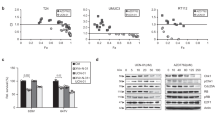Abstract
The adenovirus (Ad) E1A gene exerts an antitumor effect and can induce sensitivity to treatment with DNA-damaging agents. In contrast, the Ad 19-kDa E1B protein inhibits E1A-mediated apoptosis and the 55-kDa E1B inactivates the p53 protein. In this paper, we study the in vitro and in vivo effects of a 19-kDa and 55-kDa E1B-defective Ad in several malignant human tumor cell lines.
Materials and Methods. Nontumorigenic human fibroblasts (CCD-45SK and Hs67), peripheral blood lymphocytes, and several human tumor cell lines derived from cervix, colon, and breast carcinomas, epidermoid carcinoma, and osteosarcoma (HeLa, HT29, MCF7, Saos-2, and A431 cell lines) were studied. Wild-type (wt) Ad type 5 and H5 dL118 Ad, a mutant with the deleted E1B region, were employed. The cells were infected at 20 plaque-forming units, and cell viability was evaluated by the crystal violet method. In the in vivo experiments, 2 × 106 cells from the carcinoma cell lines HeLa, A431. and HT29 were injected into nude mice. The tumorigenicity of previously infected cells and after an intratumoral injection of Ad was analyzed. The mice received whole-body γ-irradiation.
Results. The H5 dL118 mutant produced a marked cytopathic effect in all of the malignant cells, surpassing that of the wt Ad; viability at 72 hours ranged from 11% to 20% for H5 dL118 Ad and from 70% to 93% for the wt Ad with respect to uninfected controls. In the in vivo experiments, a total inhibition of tumorigenicity was detected when cells were infected prior to injection and a partial and transitory decrease in tumorigenicity was detected when the mutant H5 dL118 was injected intratumorally. γ-irradiation enhanced the in vivo antitumor effects.
Conclusions. These results indicate that infection with completely E1B-deficient Ads induced a marked cytopathic effect on malignant cells that was higher than that seen for wt Ads; in addition, infection with such Ads exerts a tumor suppressor effect in vivo.
This is a preview of subscription content, access via your institution
Access options
Subscribe to this journal
Receive 12 print issues and online access
$259.00 per year
only $21.58 per issue
Buy this article
- Purchase on Springer Link
- Instant access to full article PDF
Prices may be subject to local taxes which are calculated during checkout
Similar content being viewed by others
Author information
Authors and Affiliations
Corresponding author
Rights and permissions
About this article
Cite this article
Duque, P., Alonso, C., Sánchez-Prieto, R. et al. Adenovirus lacking the 19-kDa and 55-kDa E1B genes exerts a marked cytotoxic effect in human malignant cells. Cancer Gene Ther 6, 554–563 (1999). https://doi.org/10.1038/sj.cgt.7700077
Received:
Accepted:
Published:
Issue Date:
DOI: https://doi.org/10.1038/sj.cgt.7700077
Keywords
This article is cited by
-
Employment of liver tissue slice analysis to assay hepatotoxicity linked to replicative and nonreplicative adenoviral agents
Cancer Gene Therapy (2006)
-
E1A-mediated suppression of EGFR expression and induction of apoptosis in head and neck squamous carcinoma cell lines
Oncogene (2003)
-
Adenovirus E1a protein enhances the cytotoxic effects of the herpes thymidine kinase-ganciclovir system
Cancer Gene Therapy (2003)
-
Intravascular injections of a conditional replicative adenovirus (adl118) prevent metastatic disease in human breast carcinoma xenografts
Gene Therapy (2001)



